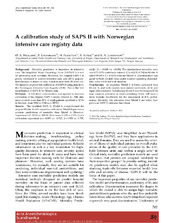| dc.contributor.author | Haaland, Øystein Ariansen | en_US |
| dc.contributor.author | Lindemark, Frode | en_US |
| dc.contributor.author | Flaatten, Hans | en_US |
| dc.contributor.author | Kvåle, Reidar | en_US |
| dc.contributor.author | Johansson, Kjell Arne | en_US |
| dc.date.accessioned | 2014-12-04T10:17:35Z | en_US |
| dc.date.accessioned | 2014-12-04T10:20:58Z | en_US |
| dc.date.accessioned | 2014-12-10T12:53:01Z | |
| dc.date.available | 2014-12-10T12:53:01Z | |
| dc.date.issued | 2014-05-12 | eng |
| dc.identifier.issn | 0001-5172 | |
| dc.identifier.uri | https://hdl.handle.net/1956/8891 | |
| dc.description.abstract | Background Mortality prediction is important in intensive care. The Simplified Acute Physiology Score (SAPS) II is a tool for predicting such mortality. However, the original SAPS II is poorly calibrated to current intensive care unit (ICU) populations because it draws on data, which is more than 20 years old. We aimed to improve the calibration of SAPS II using data from the Norwegian Intensive Care Registry (NIR). This is the first recalibration of SAPS II for Nordic data. Methods A first-level customization was applied to improve calibration of the original SAPS II model (Model A). NIR data used covered more than 90% of adult patients admitted to ICUs in Norway from 2008 to 2010 (n = 30712). Results The modified SAPS II, Model B, outperformed the original Model A with respect to calibration. Model B gave more accurate predictions of mortality than Model A (Hosmer–Lemeshow's C: 22.01 vs. 689.07; Brier score: 0.120 vs. 0.131; Cox's calibration regression: α = −0.093 vs. −0.747, β = 0.921 vs. 0.735, (α|β = 1) = −0.009 vs. −0.630). The standardized mortality ratio was 0.73 [95% confidence interval (CI) of 0.70–0.76] for Model A and 0.99 (95% CI of 0.95–1.04) for Model B. Discrimination was good for both models (area under receiver operating characteristic curve = 0.83 for both models). Conclusions As expected, Model B is better calibrated than Model A, and both models have similar uniformity of fit and equal discrimination. Introducing Model B into Norwegian ICUs may improve precision in decision-making. Units will have a more realistic benchmark for the assessment of ICU performance. Mortality risk estimates from Model B are better than previous SAPS II estimates have been. | en_US |
| dc.language.iso | eng | eng |
| dc.publisher | Wiley | eng |
| dc.rights | Attribution-NonCommercial CC BY-NC | eng |
| dc.rights.uri | http://creativecommons.org/licenses/by-nc/3.0/ | eng |
| dc.title | A calibration study of SAPS II with Norwegian intensive care registry data | en_US |
| dc.type | Peer reviewed | |
| dc.type | Journal article | |
| dc.date.updated | 2014-12-04T10:17:35Z | en_US |
| dc.description.version | publishedVersion | en_US |
| dc.rights.holder | Copyright 2014 The Authors | |
| dc.identifier.doi | https://doi.org/10.1111/aas.12327 | |
| dc.identifier.cristin | 1148595 | |
| dc.source.journal | Acta Anaesthesiologica Scandinavica | |
| dc.source.40 | 58 | |
| dc.source.14 | 6 | |
| dc.source.pagenumber | 701-708 | |

